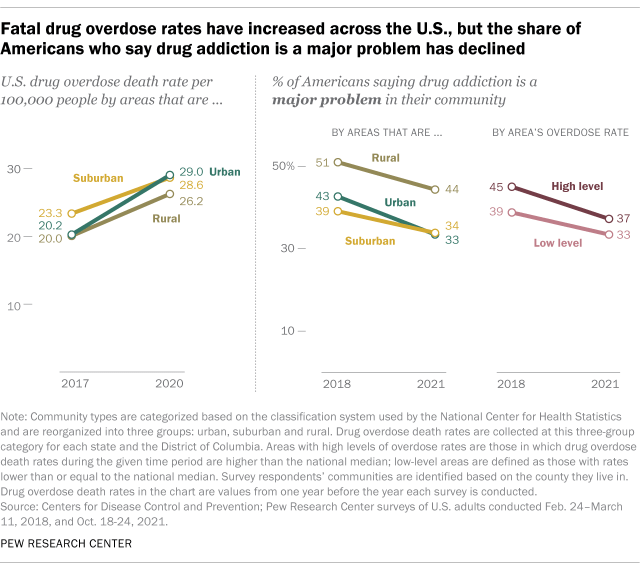The share of Americans who see drug addiction as a “major problem” in their community has declined in recent years, even as drug overdose deaths in the United States have risen sharply. Public concern about addiction is down even in the parts of the U.S. where drug overdose death rates have increased the most.

This Pew Research Center analysis examines changing public attitudes about drug addiction in the United States, including in communities that have been hit hardest by fatal drug overdoses in recent years.
The public opinion data cited here comes from two Pew Research Center surveys. The first was conducted Feb. 24-March 11, 2018, among 6,251 U.S. adults, and the second was conducted Oct. 18-24, 2021, among 9,676 U.S. adults. Everyone who took part in these two surveys was a member of the Center’s American Trends Panel (ATP), an online survey panel that is recruited through national, random sampling of residential addresses. This way nearly all U.S. adults have a chance of selection. Both surveys are weighted to be representative of the U.S. adult population by gender, race, ethnicity, partisan affiliation, education, and other categories. You can read more about the ATP’s methodology, as well as the methodology of the 2018 and 2021 surveys.
Drug overdose death rates are taken from the Centers for Disease Control and Prevention’s WONDER database – specifically, the database showing underlying causes of death for the years 1999 through 2020. The Center requested age-adjusted drug overdose death rates for the years 2017 and 2020 at three urbanization levels –urban, suburban and rural – for each state and the District of Columbia separately. While the CDC uses six urbanization levels based on National Center for Health Statistics classification system, the Center collapsed those six groups into three instead – urban, suburban and rural – following the same methodology used in a 2018 report.
In addition to examining different urbanization levels, we also grouped survey respondents into categories based on fatal drug overdose rates in their area type (urban, suburban or rural). We used respondents’ counties of residence to group them into the specified areas. One analysis groups respondents based on whether urbanization-level drug overdose death rates in their area were higher or lower than the national median at the given time period. Another groups the same respondents based on whether the change in drug overdose death rate in their area between 2017 and 2020 was higher than the median increase. Survey results may differ from previously published findings because of differences in how urban, rural and suburban classifications were defined.
Nearly 92,000 Americans died of drug overdoses in 2020, up from around 70,000 in 2017, according to the Centers for Disease Control and Prevention (CDC). During the same period, the rate of fatal overdoses rose from 21.7 to 28.3 per 100,000 people.
Despite these increases, the share of Americans who say drug addiction is a major problem in their local community declined by 7 percentage points in subsequent Pew Research Center surveys – from 42% in 2018 to 35% in 2021. And in a separate Center survey in early 2022, dealing with drug addiction ranked lowest out of 18 priorities for the president and Congress to address this year.
Fatal drug overdose rates increased in urban, suburban and rural areas of the country between 2017 and 2020. But the share of Americans who say drug addiction is a major problem decreased in all three types of areas in the Center’s subsequent surveys. These declines ranged in size from 10 percentage points in urban areas (from 43% in 2018 to 33% in 2021) to 5 points in suburban areas (from 39% to 34%).
Public concern about drug addiction has declined even in areas with high levels of drug overdose death rates. In areas of the country with higher-than-median drug overdose death rates in 2017 and 2020, the share of Americans who say drug addiction is a major problem in their community fell by 8 points between 2018 and 2021, from 45% to 37%.
This pattern is nearly identical in areas where drug overdose death rates climbed by more than the median increase between 2017 and 2020. Some 44% of Americans living in these areas said drug addiction was a major problem in their community in 2018, but that share fell to 38% in 2021.
It’s not clear why public concern about drug addiction has declined in recent years, even in areas where overdose death rates have risen quickly. Surveys by the Center show that Americans have prioritized other issues, including the national economy, reducing health care costs and dealing with the coronavirus outbreak. The increase in overdose deaths may also be overshadowed, particularly amid the high number of deaths attributed to the coronavirus outbreak (though, as of this month, far fewer see the virus as a very big problem facing the country).



